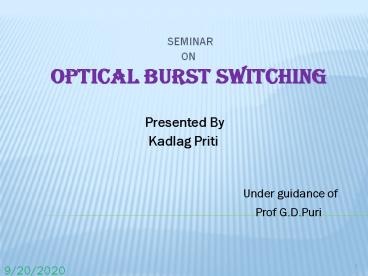SEMINAR ON Optical Burst Switching - PowerPoint PPT Presentation
Title:
SEMINAR ON Optical Burst Switching
Description:
Title: Labeled Optical Burst Switching and IP/WDM Integration Author: Chunming Qiao Description: Nokia Standard Presentation Template - LTR v. 3.1 1999/07/22 Eric Beasley – PowerPoint PPT presentation
Number of Views:578
Avg rating:3.0/5.0
Title: SEMINAR ON Optical Burst Switching
1
SEMINAR ONOptical Burst Switching
- Presented By
- Kadlag Priti
-
Under guidance of -
Prof G.D.Puri
-
2
OVERVIEW
- Optical Switching Techniques
- Problems and solution for OCS and OPS
- What is OBS
- Why OBS? A Comparison
- OBS Fundamental
- OBS Network Edge
- Actual Data Transmission In OBS
- One-way vs. two-way reservation
- One way reservation
- Packet and OBS switching mechanism
- Just Enough Time
- Advantages And Disadvantages
- Applications
- Conclusion
3
Optical Switching Techniques
- Optical Circuit Switching
- Bandwidth inefficient for bursty data (internet
traffic). - Frequent long circuit setup
- Waste bandwidth during off/low-traffic periods
- Optical Packet Switch
- A packet contains a header and the
payload(variable or fixed length). - Each node needs to buffer, process the header,
and send it to the next switch.
4
Problems and solution for OCS and OPS
- Problems
- Explosive traffic growth and bursty Traffic
pattern - Lack of optical buffer (RAM) for packet
switching. - Fiber delay lines (FDLs) are bulky and provide
only limited delays - Need fast processing of header and payload
- Solution
- Find a method between circuit switching and
packet switching. - To increase the Bandwidth efficiency.
- Thats Optical Burst Switching comes into the
picture
5
What Is OBS ...
- OBS combines benefits of OCS and OPS.
- OBS is an attempt at a new synthesis of optical
and electronic technologies. - OBS lies between OPS and WRN.
- In OBS, data is transmitted in variable size
packets called Burst. - A burst is switched to next node before its last
bit arrives which will reduce offset time. - No store and forward is required.
- It provides strong separation between control and
data plane. - It will reduce the problem of bursty traffic.
6
Why OBS? A Comparison
OBS combines the best of circuit-switching and
packet-switching
7
OBS Fundamentals
- In an OBS network, various types of client
data are aggregated at the - ingress (an edge node) and transmitted as
data bursts which later will be - disassembled at the egress node.
- The process of burst assembly is called as the
burstification.
9/20/2020
8
OBS Network Edge
- Network Edge OBS users perform the following four
functions - Burst assembly
- Signaling
- Routing wavelength assignment
- Computation of offset time for control packet
9/20/2020
9
Data Transmission In OBS
- Data is transported in variable sized units
called bursts. - When a burst is ready, reservation request is
sent to the next resource. - Data is sent shortly after the reservation
request, without receiving an acknowledgement of
successful reservation. - Control and data signals are send on different
channels. - There are two protocols for data transmission in
OBS namely JET and JIT.
10
One-way vs. two-way reservation
- In one-way reservation, burst is sent out after
prespecified delay, called offset, without
waiting for acknowledgment (ACK) that connection
has been established. - In conventional two-way reservation, source OBS
user would wait for ACK before sending any data. - Benefit of one-way reservation
- Significantly decreases connection set-up time to
one-way end-to-end propagation delay plus time
required to process control packet configure
optical switch fabric at intermediate OBS nodes. - Shortcoming of one-way reservation
- Burst can be lost since control packets may not
be successful in setting up connections due to
congestion on data wavelength channels. - Retransmission of lost bursts is complex.
11
ONE WAY RESERVATION
12
Packet (a) and OBS(b) switching
13
Just-Enough-Time (JET)
- JET is a special protocol for reservation of
resources for burst. - Basic ideas
- Each control packet carries the information like
offset time and burst length. - The offset time is chosen so that no optical
buffering or delay is required at the
intermediate nodes. - Delayed reservation the reservation starts at
the expected arrival time of the burst
14
Just In Time (JIT)
- Connection establishment.
- Connection tear down.
- Connection failure due to request rejection.
- Connection failure due to data lost.
9/20/2020
15
Advantages And Disadvantages
- Advantages
- More efficient bandwidth utilization.
- Remove throughput limitation.
- Guard band between burst and header.
- Reduce processing requirements.
- Energy consumption.
- Disadvantages
- Limited/No QoS.
- Less processing speed.
- Noise Problem
9/20/2020
16
Applications
- OBS supports multiservice traffic offering
high - bandwidth efficiency and low latency.
- File transfers.
- Multimedia Application like restore films,
- add videos, edit video clips etc.
9/20/2020
17
Conclusion
- Optical packet and circuit switching were
discussed and compared to the new OBS switching
technique. - OBS is a very promising switching technique that
will most likely be adopted in the future. - Optical burst switching (OBS) as an efficient way
to resolve the problem of congestion that the
Internet is suffering from.
18
Thank You
19
Any Questions ?































